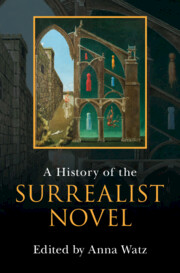Book contents
- A History of the Surrealist Novel
- A History of the Surrealist Novel
- Copyright page
- Dedication
- Contents
- Figures
- Contributors
- Acknowledgements
- Introduction
- I Marvellous Beginnings
- Chapter 1 Autobiography
- Chapter 2 Diverging Genealogies of the Surrealist Unconscious
- Chapter 3 Automatism, Autobiography, and Thanatography in the Surrealist Novel
- Chapter 4 Urban Nature: The City in the Surrealist Novel
- Chapter 5 Nostalgia and Childhood in the Surrealist Novel
- Chapter 6 Surrealist Collage Narrative
- II Transgression and Excess
- III Science, Alchemy, Nature
- IV Transnational Surrealism
- Index
Chapter 2 - Diverging Genealogies of the Surrealist Unconscious
from I - Marvellous Beginnings
Published online by Cambridge University Press: 02 February 2023
- A History of the Surrealist Novel
- A History of the Surrealist Novel
- Copyright page
- Dedication
- Contents
- Figures
- Contributors
- Acknowledgements
- Introduction
- I Marvellous Beginnings
- Chapter 1 Autobiography
- Chapter 2 Diverging Genealogies of the Surrealist Unconscious
- Chapter 3 Automatism, Autobiography, and Thanatography in the Surrealist Novel
- Chapter 4 Urban Nature: The City in the Surrealist Novel
- Chapter 5 Nostalgia and Childhood in the Surrealist Novel
- Chapter 6 Surrealist Collage Narrative
- II Transgression and Excess
- III Science, Alchemy, Nature
- IV Transnational Surrealism
- Index
Summary
One can ascribe a double origin to surrealism in 1924, André Breton’s First Manifesto of Surrealism and Louis Aragon’s A Wave of Dreams. If one can see these texts as a double manifesto recapitulating previous experiments and launching a programme, they also plant the seeds for a later divergence. I locate the roots of the breakup between Aragon and Breton less in their politics than in opposed conceptions about the role of the novel and its power to explore the unconscious. Such a divergence is founded upon different interpretations of Freud’s concept of the unconscious. The two founders of surrealism could not agree about the place of a collective unconscious in a surrealist mythology, which can be verified by comparing Anicet and The Paris Peasant on the one hand, and Nadja on the other. I conclude by returning to Walter Benjamin’s critical assessment of surrealism. Halfway between Breton and Aragon, Benjamin identified some pitfalls in a surrealist mythology of the unconscious but intuited what could be gained from a writing capable of exploring reality and surreality together.
- Type
- Chapter
- Information
- A History of the Surrealist Novel , pp. 39 - 55Publisher: Cambridge University PressPrint publication year: 2023



